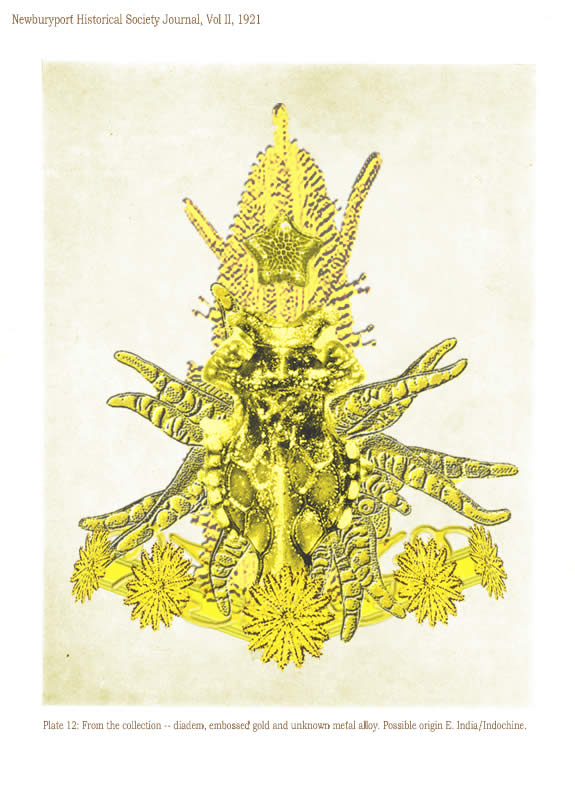
NEWBURYPORT HISTORICAL SOCIETY |
||

"Most interesting of all was a glancing reference to the strange jewelry vaguely associated with Innsmouth. It had evidently impressed the whole countryside more than a little, for mention was made of specimens in the museum of Miskatonic University at Arkham, and in the display room of the Newburyport Historical Society. The fragmentary descriptions of these things were bald and prosaic, but they hinted to me an undercurrent of persistent strangeness. Something about them seemed so odd and provocative that I could not put them out of my mind, and despite the relative lateness of the hour I resolved to see the local sample--said to be a large, queerly-proportioned thing evidently meant for a tiara--if it could possibly be arranged."
"The librarian gave me a note of introduction to the curator of the Society, a Miss Anna Tilton, who lived nearby, and after a brief explanation that ancient gentlewoman was kind enough to pilot me into the closed building, since the hour was not outrageously late. The collection was a notable one indeed, but in my present mood I had eyes for nothing but the bizarre object which glistened in a corner cupboard under the electric lights."
"It took no excessive sensitiveness to beauty to make me literally gasp at the strange, unearthly splendour of the alien, opulent phantasy that rested there on a purple velvet cushion. Even now I can hardly describe what I saw, though it was clearly enough a sort of tiara, as the description had said. It was tall in front, and with a very large and curiously irregular periphery, as if designed for a head of almost freakishly elliptical outline. The material seemed to be predominantly gold, though a weird lighter lustrousness hinted at some strange alloy with an equally beautiful and scarcely identifiable metal. Its condition was almost perfect, and one could have spent hours in studying the striking and puzzlingly untraditional designs--some simply geometrical, and some plainly marine--chased or moulded in high relief on its surface with a craftsmanship of incredible skill and grace."
"The longer I looked, the more the thing fascinated me; and in this fascination there was a curiously disturbing element hardly to be classified or accounted for. At first I decided that it was the queer other-worldly quality of the art which made me uneasy. All other art objects I had ever seen either belonged to some known racial or national stream, or else were consciously modernistic defiances of every recognized stream. This tiara was neither. It clearly belonged to some settled technique of infinite maturity and perfection, yet that technique was utterly remote from any--Eastern or Western, ancient or modern--which I had ever heard of or seen exemplified. It was as if the workmanship were that of another planet."
"However, I soon saw that my uneasiness had a second and perhaps equally potent source residing in the pictorial and mathematical suggestion of the strange designs. The patterns all hinted of remote secrets and unimaginable abysses in time and space, and the monotonously aquatic nature of the reliefs became almost sinister. Among these reliefs were fabulous monsters of abhorrent grotesqueness and malignity--half ichthyic and half batrachian in suggestion--which one could not dissociate from a certain haunting and uncomfortable sense of pseudomemory, as if they called up some image from deep cells and tissues whose retentive functions are wholly primal and awesomely ancestral. At times I fancied that every contour of these blasphemous fish-frogs was over-flowing with the ultimate quintessence of unknown and inhuman evil."
"In odd contrast to the tiara's aspect was its brief and prosy history as related by Miss Tilton. It had been pawned for a ridiculous sum at a shop in State Street in 1873, by a drunken Innsmouth man shortly afterward killed in a brawl. The Society had acquired it directly from the pawnbroker, at once giving it a display worthy of its quality. It was labeled as of probable East-Indian or Indochinese provenance, though the attribution was frankly tentative."
"Miss Tilton, comparing all possible hypotheses regarding its origin and its presence in New England, was inclined to believe that it formed part of some exotic pirate hoard discovered by old Captain Obed Marsh. This view was surely not weakened by the insistent offers of purchase at a high price which the Marshes began to make as soon as they knew of its presence, and which they repeated to this day despite the Society's unvarying determination not to sell."
"As the good lady shewed me out of the building she made it clear that the pirate theory of the Marsh fortune was a popular one among the intelligent people of the region. Her own attitude toward shadowed Innsmouth--which she never seen--was one of disgust at a community slipping far down the cultural scale, and she assured me that the rumours of devil-worship were partly justified by a peculiar secret cult which had gained force there and engulfed all the orthodox churches." -- The Shadow Over Innsmouth